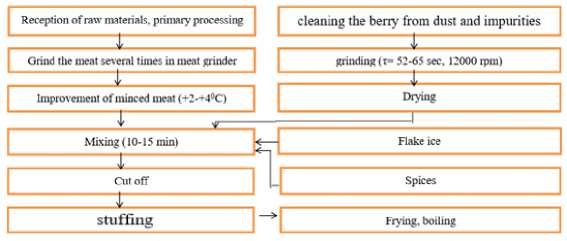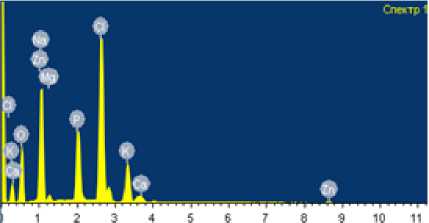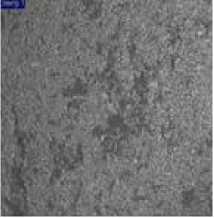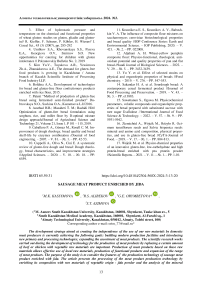Sausage meat product enriched by jida
Автор: Kassymova M.K., Alibekov R.S., Orymbetova G.E., Azimova S.T.
Журнал: Вестник Алматинского технологического университета @vestnik-atu
Рубрика: Технология пищевой и перерабатывающей промышленности
Статья в выпуске: 3 (145), 2024 года.
Бесплатный доступ
The development strategy aimed at creating the independence of the use of our raw materials by domestic meat producers is currently achieving the following goals: building modern production facilities and introducing new primary and processing technologies; expanding the assortment of meat products. The scientific research works carried out during the development of technology for the production of meat products by replacing a certain amount of beef or chicken with vegetable raw materials are important. Production of meat products based on these raw materials allows effective use of local raw materials, production of functional products and expansion of the range of meat products. The purpose of the study is to consider the features of the production technology of sausage meat product enriched with jida. The article presents the processing of the meat product production technology by enriching its composition with raw materials of vegetable origin - jida powder and the analysis of the mineral content of the finished product. The research work was carried out at the "Food Engineering" department of the M. Auezov South Kazakhstan University and at the "Construction and Biochemical Materials" regional test laboratory of engineering profile. Raster electron microscope (REM) and inductively coupled plasma mass spectrometry (ICP-MS) methods were used to determine the amount of mineral substances in meat products - sausage. The specialty of this work is the technology of product production using vegetable raw materials to enrich the content of meat products - sausages with minerals. Vegetable raw material - jida powder, by using it in the production of functional meat products, enriches the mineral content of meat products, and also by replacing a small part of meat raw materials, contributes to increasing the yield of the product. Jida powder is a vegetable raw material that is soluble in cold water and rich in dietary fiber, vitamin C, flavonoids and organic acids and does not cause losses in the production of food product. Jida powder production technology consists of: cleaning berries from dust and impuri[1]ties (passing them through a sorting fan); crushing (optimal duration of berry crushing in the IV-1 crusher τ= 52-65 sec, rotation speed of the working body 12000 rpm); drying (dry in the sun for fruits with a high sugar content).
Sausage, jida powder, milling, mineral composition, kiełbasa
Короткий адрес: https://sciup.org/140307003
IDR: 140307003 | DOI: 10.48184/2304-568X-2024-3-13-20
Текст научной статьи Sausage meat product enriched by jida
Currently, market of meat products in our country is significantly developed. In our country, market is aimed at creating the independence of domestic meat producers in the use of our own raw materials. A strategy for the development of industry has been developed, which considers number of different solutions for development of production. Thus, the following goals are currently being achieved:
-
- construction of modern production facilities, introduction of new primary and recycling technologies;
-
- expanding assortment of meat products.
Various segments such as commercial meat, processed meat products and various semifinished products are included in the meat products market. Sausage products take big place among them.
The market of sausage products is filled with products of Russian and foreign manufacturers, and domestic manufacturers occupy up to 90% of the entire market. Today, the consumer has a lot of choice: about 6,000 types of sausage are offered on store shelves.
Meat products are frequently consumed products and are important in human nutrition. The demand for such products does not decrease, but only increases, which is primarily explained by its high nutritional value and taste.
And children love sausage. As one of sausage products, expansion of ingredient set of product recipe is necessary to eliminate contradictions such as the chemical composition and cost of product, keeping the percentage of individual ingredients unexpensive expensive [1-3].
The optimal ratios between calcium and phosphorus, calcium and magnesium are 1: (1.5-
-
1.7) and 1: (0.5-0.7), respectively. There is no other product in nature with this ratio. The ratio of calcium and magnesium in bread, meat and potatoes is 1:2, in milk and kefir - 1:0.1, in many vegetables and fruits - 1:4.5. Achieving such a ratio is very difficult when formulating recipes, so it is important to simplify these criteria.
It has been proven that the functional properties of meat products can be increased with the use of plant raw materials [4]. The jida is a sugary berry useful for the body, it contains mineral salts of phosphorus and potassium, also important amino acids, tannins and organic acids. The chemical composition of jida includes ascorbic acid, and the peel contains alkaloids, dyes and tannins.
The conducted literature review showed that production of functionally oriented meat products enriched with vegetable raw materials is one of the promising directions of today's meat production [5,6]. In this regard, scientific research work is being carried out during development of technology production of meat products enriched by raw jida vegetable raw materials based on beef and chicken. The production of meat products enriched with vegetable raw materials makes it possible to use local raw materials rationally, to create functional meat products and to increase the segment of meat products.
The purpose of work is to consider the peculiarities of the production technology of sausage meat product enriched by jida.
Materials and research methods
Research on the mineral composition of sausage with jida powder was carried out at the "Food Engineering" department of M. Auezov South Kazakhstan University and at the "Construction and Biochemical Materials" regional test laboratory of engineering.
Methods for determining amount of mineral substances in sausage products: scanning electron microscope (REM) and inductively coupled plasma mass spectrometry (ICP-MS) method.
Raster electron microscope (REM) or scanning electron microscope is an electron microscope designed to obtain an image of the surface of an object with a size of up to 0.4 nanometers, as well as information about the composition, structure and some other properties of surface layers. The operating principle of a scanning electron microscope is based on the fact that an electron beam of different energies emanates from it.
Unlike an optical microscope the magnification power of a modern microscope reaches 1,000,000, which is tens of times higher than the resolution of the optical device; the ability to create the greatest depth of field; can keep large objects clearly and evenly in focus and produce high-quality photos. Which means a scanning electron microscope is a device that can show what optical microscopy cannot see.
Today, the scanning electron microscope is used in all fields of science and industry, from biology to materials science.
Different structures and types of REMs are known, manufactured by number of companies, equipped with different types of detectors. In our case, resolution of an optical microscope (ability to distinguish small particles) is limited by the wavelength of visible light photons. The most powerful optical microscopes can see particles with a size of 0.1–0.2 μm [7]. If you shorten the wavelength that illuminates the research object, you can see fine details. Instead of photons, electrons with a much shorter wavelength can be used for this. Electron microscopes are the result of this idea.
Inductively coupled plasma mass spectrometry (ICP-MS) is a very fast, efficient and highly sensitive method for simultaneous quantification of many elements in wide concentration range of liquid, solid and gaseous samples. This method is possible and has wide scope of application [8].
Review literature
An analysis comparing the addition of rosemary oleoresin (200 ppm) to an antioxidant mixture of butylated hydroxyanisole (BHA), butylated hydroxytoluene (BHT) (200 ppm) and citric acid in frozen and freeze-dried breakfast sausages made from 18% mechanically deboned turkey showed positive results in the freeze-dried sausages. It has been known to inhibit lipid oxidation during 5 weeks of storage [9].
To investigate the effect of three proteases (Streptomyces griseus proteinase E, Aspergillus oryzae aspartyl proteinase and papain) on protein degradation and sensory characteristics of dry fermented sausages fermented with water-soluble, non-protein, 5% phosphorous tungstic acid soluble, 5% sulfosalicylic acid soluble and total volatile basic nitrogen content. confirmed that it increases and stabilizes until the end of maturity (26th day) [10]. Nitrogen values were always higher in the sample supplemented with aspartyl proteinase compared to samples supplemented with the other two proteases, and changes in total free amino acids were seen at 5% sulfosalicylic acid. According to the results of electrophoretic studies, proteolysis of high molecular weight myofibrillar and sarcoplasmic proteins was more observed in samples with added protease. This was especially intense in papain.
Sausage product prepared with established quality indicators: improved organoleptic properties, increased protein and balanced amino acid composition, i.e. results of research aimed at developing a new product have proven the positive effect of grown wheat, corn seeds and kelp [11].
It is known that with introduction of new standards, traditional range of requirements for the classification and quality of cooked sausages has changed [12].
The selection of special antioxidants of plant origin has not yet been proven at stage of creating technological plan for production of sausage products.
Results and discussion
Additives should have an antioxidant effect, convenient for the manufacturer to use so that they do not require preparation costs for introduction into minced meat. Such mixtures are dry powders of vegetable origin with a slight characteristic odor, which dissolve easily in cold water and form an aqueous extract. They are introduced into minced meat during cooking (at the last stage, the biologically active substances that make up the mixture are less exposed to mechanical effects).
Jida powder is plant-based mixture that dissolves in cold water, does not cause losses in process of adding it to minced meat, contains dietary fiber, vitamin C, flavonoids and organic acids. The production technology of jida powder consists of the following stages: cleaning of jida from dust and impurities (passing through a sorting fan); crushing (optimum duration of jida crushing in the IV-1 crusher τ= 52-65 sec, rotation speed of the working body 12000 rpm); drying (drying in the sun for fruits with a lot of sugar).
The chemical composition of vegetable ingredients differs mainly with carbohydrates, proteins, lipids, biologically active substances (organic acids, mineral substances, polyphenols).
Generally, value of finished product obtained as result of drying is influenced by biologically active substances and protein.
Almost all of mineral substances and cellulose included in biologically active substance are preserved during drying process [13,14]. And most of rest undergo changes such as partial hydrolysis, enzymatic blackening, and changes in composition.
The mineral composition of jida is rich: amount of macro and microelements K - 370 mg; Ca-65 mg; Na – 32 mg; Mg - 69 mg; Te is 1.5 mg. It contains vitamin C (10.0±0.1 mg), vitamin A (5.0±0.1 mg), vitamin E (3.5±0.1 mg) and β-carotene (8.0 ±0.1 mg).
According to GOST R 52196-2003, use of sodium nitrite in range of 5.0-7.5 mg/100 g is provided for in sausage recipe. Traditionally, sodium ascorbate is used in amount of 50-100 g/100 kg of minced meat, glucose or sugar in amount of 100-200 g to adjust color of meat product (intensification of product color formation process).
Based on experimental data, optimal amount of sodium nitrite, sodium ascorbitate and sugar was set at 7.5 g, 100 g and 50 g, respectively, per 100 kg of minced meat. According to GOST, sugar should be 100-200 g. The remaining amount was supplemented with berry powder. In this case, amount of sodium nitrite does not exceed the maximum permissible value (0.005%), also intensity and stability of color of minced meat with acceptable organoleptic characteristics. However, use of sodium ascorbate and sugar-sugar in large quantities does not affect the sodium nitrite residue and the intensity of the color of minced meat. Taking into account the organoleptic characteristics, optimal amount of table salt for sausage was determined to be 2.6 g/100 g of minced meat. The following technological scheme was used in the production of sausages (Fig. 1).

Figure 1. Technological scheme in production of sausages stuffing
The mineral composition of the obtained product is given in Figure 2.

Figure 2. Mineral composition of sausage without additives

Figure 3. Mineral composition of sausage with 1% admixture

Figure 4. Mineral composition of sausage with 3% admixture

The mineral composition of the sausage also changed as the amount of mixture - jida powder increased. When jida powder was added to finished product, zinc appeared and its amount was 0.56 and 0.78% by weight, respectively. In addition, amount of magnesium is 1.03% by weight, from 1.11 to 1.11%, and amount of phosphorus is 8.92, respectively; 9.08; 9.57% by weight; potassium - 8.25; 8.63; 8.97, and calcium -0.75; 0.74; It was 0.97% by weight. Basically, the ratio of calcium and magnesium, calcium and phosphorus in sausage is 1:0.88, respectively; It was 1:9.9. Calcium must also be in balance with potassium. The balance of calcium with potassium and magnesium is an important factor in prevention of cardiovascular diseases.
If 40% of magnesium is metabolically active in body, remaining amount can be mobilized to maintain homeostasis [15-19]. As the amount of calcium increases, magnesium deficiency occurs. However, ratio of calcium and magnesium is preserved in sausage. Therefore, we think that there will be no problem. In addition, Ca-Mg balance plays an important role in Ca-P metabolism.
The content of phosphorus in sausage was 8.9-9.6% by weight. That is, product is rich by phosphorus.
Conclusion
An analysis of the mineral composition of the sausage product with the addition of berry powder, which is similar to flour, was made. The analysis showed that berry powder differs in carbohydrates, proteins, lipids, biologically active substances (organic acids, mineral substances, polyphenols). This fact revealed that it is effective and possible to use berry powder as an additive in the production of meat-vegetable sausages.
Acknowledgment, conflict of interest (funding)
The authors gratefully acknowledge to the “Science Committee of the Ministry of Science and Higher Education of the Republic of Kazakhstan” for the financial support of the research project “Complex waste-free processing of agricultural raw materials of animal and vegetable origin” within the framework of Programme Targeted Funding No. BR18574252.
The authors declare that there is no conflict of interest.
Список литературы Sausage meat product enriched by jida
- Kochieva I.V. Tehnologiya i recepturnyj sostav myasorastitelnyh sosisok [Technology and recipe composition of meat-and-vegetable sausages] / I.V.Kochieva, Z.R.Ibragimova, I.G.Doeva, O.R.Panina //Izvestiya Vuzov. Pishevaya tehnologiya [News of Universities. Food technology]. No.1, pp. 38-40, 2010. [In Russian]
- Isaeva K. S. Sozdanie polifunkcionalnyh produktov iz myasnogo i rastitelnogo syrya [Creation of multifunctional products from meat and vegetable raw materials] / K.S.Isaeva, A. S. Muhamedzhanova //Monografiya [Monograph], Pavlodar: Kereku. 79 p., 2015. [In Russian]
- Klyuchnikova, O.V. Rastitelnoe syre v sozdanii myasnyh produktov funkcionalnogo naznacheniya [Plant raw materials in the creation of functional meat products] / O.V.Klyuchnikova, E.A.Skogoreva, N.P.Kozhevnikova, V.S. Slobodyanik // Materialy III obsherossijskogo studencheskogo nauchnogo foruma [Materials of the III All-Russian Student Scientific Forum]. No 7, 120 p., 2011. [In Russian]
- Kochieva I.V. Perspektivnyj antioksidant rastitelnogo proishozhdeniya [Promising antioxidant of plant origin] / Kochieva I.V., Plotnikov E.E., Parshin G.S. and others // Myasnaya industriya [Meat industry]. No 7, pp.60-62, 2008. [In Russian]
- Kassymova M.K. Halal beef sausage products using malt / M.K.Kassymova, R.S.Alibekov, Z.I.Kobzhasarova, G.E.Orymbetova, K.A.Urazbayeva //Reports of the National Academy of sciences of the Republic of Kazakhstan, Volume 2. Number 346 (2023), 120-127.
- Kassymova M.K. Et nany tehnologiasyn jasaudağy zamanaui jetıstıkter [Modern advances in meat loaf technology] / M.K.Kassymova, K.B.Tleubergenova // «Auezov oqulary -19: täuelsız Qazaqstanğa 30 jyl» atty halyqaralyq ğylymi-täjıribelık 221konferensiasynyñ eñbekterı [Proceedings of the international scientific-practical conference "Auezov studies -19: 30 years of independent Kazakhstan"]. pp.267-270, 2021. [in Kazakh]
- Saharov N.V. Rastrovaya elektronnaya mikroskopiya: uchebnoe popsobie [Scanning electron microscopy: tutorial] /N.V.Saharov, M.A.Fadeev. N. - Novgorod: Nizhegorodskij gosuniversitet [N. Novgorod: Nizhny Novgorod State University], 96 p., 2020. [In Russian]
- Gilmutdinov R.R. Mass - spektroskopiya s induktivno-svyazannoj plazmoj. Metodicheskie ukazaniya k laboratornoj rabote [Spectroscopy with inductively coupled plasma. Guidelines for laboratory work] / R.R.Gilmutdinov -Kazan. 21 p. 2020. [In Russian]
- Barbut, S., Draper, H. H., & Hadley, M. (1988). Effects of freezing method and antioxidants on lipid oxidation in turkey sausage. Journal of Food Protection, 51(11), 878-882.
- Diaz, O., Fernandez, M., Garcia De Fernando, G. D., de la Hoz, L., & Ordoñez, J. A. (1997). Proteolysis in dry fermented sausages: The effect of selected exogenous proteases. Meat Science, 46(1), 115- 128. https://doi.org/10.1016/S0309-1740(97)00013-2
- Gorlov I.F, Lodianov V.V, Barannikov V.A, Gekhaev B.N, Knyazhechenko O.A. and Struk E.A. (2020) Influence of plant-based additives on the biological value of sausage products IOP Conference Series Earth and Environmental Science 548(8):082085 https://doi.org/10.1088/1755-1315/548/8/082085
- Krishtafovich V.I. and Krishtafovich D.V. (2018) Assortment and quality requirements for boiled sausages according to various regulatory documents Commodity expert on food products 3. 16- 21
- Kasymova M.K. Emülsialyq tūzdyq öndırude jide men bidai öskını ūnyn qoldanu [Use of jida and wheat germ flour in the production of emulsion sauce]/ M.K.Kasymova, Z.İ.Kobjasarova, G.E.Orymbetova, G.Nurynbetova // Almaty tehnologialyq universitetınıñ Habarşysy [Bulletin of Almaty Technological University]. No 2, pp.50-54, 2018. [in Kazakh]
- Orymbetova G.E. Application of haccp system for the meat-plant pasteproduction / G.E.Orymbetova, R.S.Alibekov, E.A.Gabrilyants, K.A.Urazbayeva, M.K.Kassymova, Z.I.Kobzhasarova //News of the national academy of sciences of the republic of kazakhstan series chemistry and technology.- 2023.-Volume 2, No 455: 151-164
- Chekman I.S. Magnij v medicine [Tekst] [Magnesium in medicine] / I.S.Chekman, N.A.Gorchakova, S.L.Nikolaj - Kishinev, 1992: 100. - ISBN 5-376-01316-2. [In Russian]
- Bobreneva, I.V. Netradicionnye rastitelnye dobavki i ih ispolzovanie v myasnyh produktah [Nontraditional herbal additives and their use in meat products] / I.V.Bobreneva, A.A. Bayumi //Myasnaya industriya [Meat industry]. No 7, pp. 25 - 29, 2019. [In Russian]
- Ispergenov T.A. Issledovanie vliyaniya rastitelnoj dobavki na kachestvo kolbasnyh izdelij [Study of the influence of herbal additives on the quality of sausages] / T.A.Ispergenov // Materialy Respublikanskoj nauchno-teoreticheskoj konferencii «Sejfullinskie chteniya-11: Molodezh i nauka» [Materials of the Republican Scientific and Theoretical Conference “Seifullin Readings-11: Youth and Science”]. Volume І, Part 1, pp. 245-249, 2015. [In Russian]
- Nurgalieva B.A. Primenenie rastitelnogo syrya v proizvodstve myasnyh polufabrikatov [Application of plant raw materials in the production of semi-finished meat products] / B.A.Nurgalieva, Zh.H.Kakimova, G.O.Mirasheva, G.M.Bajbalinova //Vestnik universiteta Shakarima. Seriya tehnicheskie nauki [Shakarim University Bulletin. Technical Science Series]. No 1(1), pp. 34-36, 2021. [In Russian]
- Ponomareva T.A. Proizvodstvo myasnyh rublenyh polufabrikatov s ispolzovaniem netradicionnogo syrya [Production of chopped semi-finished meat products using non-traditional raw materials] / T.A.Ponomareva // Nauka YuUrGU. Sekciya tehnicheskih nauk: Mater. 67-j nauchnoj konf. [Science SUSU. Section of Technical Sciences: Mater. 67th scientific conference] - SUSU. - Chelyabinsk, -pp. 569-573, 2015. [In Russian]


